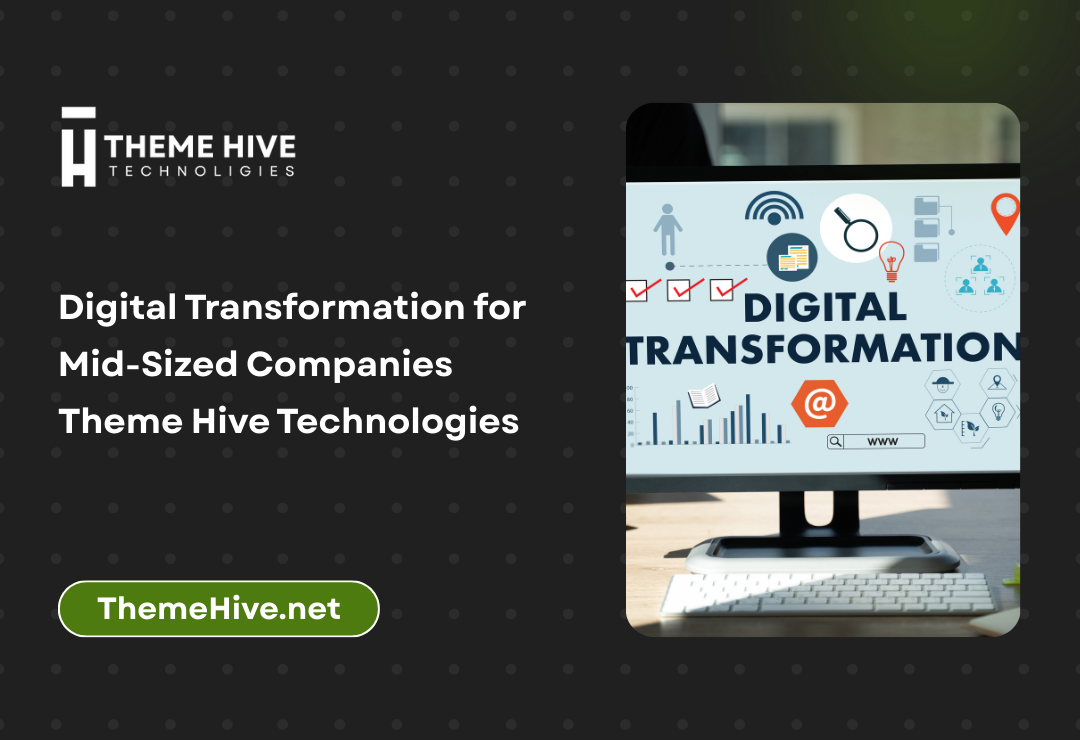In today’s rapidly evolving digital economy, no business can afford to remain static. Technology is redefining how organizations operate, compete, and deliver value to customers. While large corporations often lead the charge in adopting cutting-edge innovations, digital transformation for mid-sized companies is equally critical. Mid-sized organizations must modernize processes, adopt new tools, and embrace digital strategies to remain competitive in an increasingly technology-driven market.
Unlike small startups, mid-sized companies have established customer bases, legacy systems, and organizational structures. At the same time, they may lack the vast resources available to large enterprises. This balance makes digital transformation both a challenge and an opportunity. By leveraging the right technologies and approaches, mid-sized businesses can drive efficiency, improve customer experiences, and open new revenue streams.
In this comprehensive guide, we will explore the importance of digital transformation, the challenges mid-sized companies face, the strategies they can adopt, and the role of partners like ThemeHive Technologies and Theme Hive Technologies in accelerating transformation initiatives.
What is Digital Transformation?
Digital transformation refers to the integration of digital technology into all areas of a business. It fundamentally changes how companies operate, interact with customers, and deliver value. This transformation goes beyond technology alone—it also requires cultural change, new processes, and a willingness to challenge traditional practices.
Key components of digital transformation include:
- Automation – Streamlining repetitive tasks with tools and software.
- Cloud Computing – Shifting infrastructure and applications to cloud platforms.
- Data Analytics – Leveraging big data to guide decision-making.
- Customer Experience Enhancement – Using digital tools to improve engagement and satisfaction.
- Cybersecurity – Ensuring safe and secure digital operations.
For mid-sized companies, transformation is often about using technology as a growth enabler rather than just a cost saver.
Why Digital Transformation Matters for Mid-Sized Companies
- Competitive Pressure – Larger companies often dominate markets with digital-first strategies. Mid-sized firms must modernize to remain relevant.
- Customer Expectations – Today’s customers demand personalized, seamless digital experiences.
- Operational Efficiency – Automation and cloud platforms reduce costs and increase productivity.
- Scalability – Digital systems allow companies to expand into new markets without proportional increases in cost.
- Risk Management – With rising cyber threats, digital tools enhance security and resilience.
Digital transformation ensures mid-sized companies do not fall behind in a competitive business environment.
Challenges in Digital Transformation for Mid-Sized Companies
While the benefits are clear, mid-sized organizations face unique challenges:
- Budget Limitations – Resources are larger than small businesses but limited compared to enterprises.
- Legacy Systems – Older infrastructure may not integrate with new digital platforms.
- Change Management – Employees may resist new tools and workflows.
- Talent Gaps – Skilled IT professionals may be hard to recruit and retain.
- Cybersecurity Risks – Inadequate investment in security can expose vulnerabilities.
These hurdles require careful planning, leadership commitment, and the right technology partners.
Key Areas of Digital Transformation for Mid-Sized Companies
1. Cloud Adoption
Moving to the cloud allows mid-sized companies to scale operations, reduce IT costs, and improve collaboration. Cloud-based tools like Microsoft Azure, AWS, and Google Cloud offer enterprise-grade services at flexible costs.
2. Process Automation
Robotic process automation (RPA) and workflow automation tools eliminate repetitive tasks, allowing employees to focus on high-value activities. For example, automating invoice processing reduces manual errors and speeds up operations.
3. Data-Driven Decision Making
Data analytics platforms help businesses identify trends, understand customer behavior, and forecast future demand. Tools like Tableau and Power BI make advanced analytics accessible to mid-sized organizations.
4. Customer Experience Enhancement
Digital transformation should prioritize customer-centric strategies. Chatbots, CRM systems, and personalized marketing campaigns improve satisfaction and loyalty.
5. Cybersecurity Integration
As companies digitize, cyber risks increase. Investing in identity management, endpoint protection, and data encryption ensures that customer and company information remains secure.
6. Workforce Empowerment
Digital tools like collaboration platforms (Slack, Microsoft Teams, Zoom) enable remote work and enhance team productivity.
The Role of Leadership in Digital Transformation
Leadership plays a vital role in driving transformation. For mid-sized companies:
- Vision – Leaders must articulate a clear vision of how digital strategies align with company goals.
- Culture – Transformation requires fostering a culture of adaptability and innovation.
- Change Management – Communication and training are essential for ensuring employee buy-in.
- Investment Prioritization – Leaders must allocate resources strategically to maximize ROI.
Best Practices for Digital Transformation
- Start Small, Scale Fast – Begin with pilot projects and expand successful initiatives.
- Focus on Customer Needs – Technology investments should directly improve customer experiences.
- Leverage Partnerships – Collaborating with technology providers ensures smoother implementation.
- Measure Progress – Use KPIs to track the success of digital initiatives.
- Continuous Learning – Encourage employees to upskill and adapt to new technologies.
The Role of ThemeHive Technologies in Digital Transformation
For many mid-sized companies, navigating digital transformation alone can be overwhelming. ThemeHive Technologies and Theme Hive Technologies provide comprehensive IT solutions tailored to the needs of mid-sized organizations. Their expertise in cloud integration, automation, cybersecurity, and data analytics helps businesses accelerate transformation while minimizing risks.
By partnering with them, companies gain access to:
- Expert consulting services.
- Seamless technology integration.
- Customized solutions aligned with business goals.
- Ongoing support and training for employees.
These services empower mid-sized businesses to thrive in the digital age.
Case Studies: Mid-Sized Companies Succeeding with Digital Transformation
- Retail Company – A mid-sized retailer moved operations to the cloud, enabling real-time inventory tracking and personalized marketing campaigns.
- Healthcare Provider – By adopting telehealth platforms and secure digital records, a healthcare provider improved patient outcomes and reduced costs.
- Manufacturing Firm – Using IoT devices and predictive analytics, a manufacturing company reduced downtime and increased production efficiency.
These examples show that digital transformation is not limited to large enterprises—it is achievable and beneficial for mid-sized companies as well.
Future of Digital Transformation for Mid-Sized Companies
The digital landscape continues to evolve. Future trends that mid-sized companies must watch include:
- Artificial Intelligence (AI) Adoption – From predictive analytics to customer service automation.
- 5G Connectivity – Enhancing mobile capabilities and IoT applications.
- Blockchain Integration – Providing transparency and security in transactions.
- Sustainable Tech – Implementing eco-friendly digital solutions.
- Personalization at Scale – Delivering hyper-personalized experiences through advanced data use.
Mid-sized companies that stay agile and embrace these innovations will thrive in the coming years.
Conclusion
Digital transformation for mid-sized companies is no longer optional—it is essential for survival and growth. By adopting cloud technologies, automation, analytics, and cybersecurity, businesses can improve efficiency, enhance customer experiences, and remain competitive in the digital-first economy.
Partners like ThemeHive Technologies and Theme Hive Technologies provide the guidance and expertise needed to navigate this journey successfully. With the right strategies and support, mid-sized companies can achieve sustainable growth and secure their place in the future of business.
Internal Links for Further Reading
Outbound Authority Links
- McKinsey Digital Transformation Insights
- Gartner Research on Digital Transformation
- Forrester Digital Business Trends
Word Count: 2600







